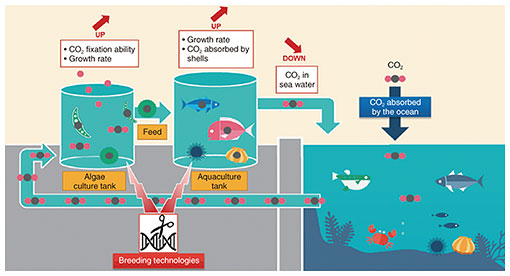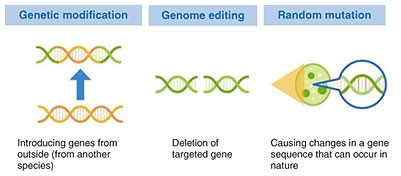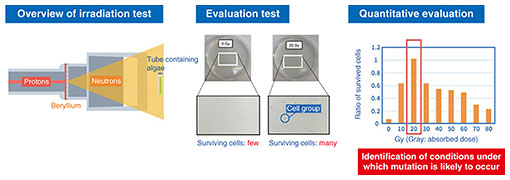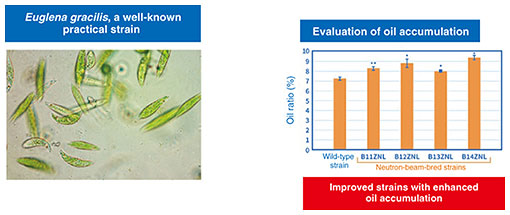 |
|
|
|
|
|
Front-line Researchers Vol. 23, No. 6, pp. 1–7, June 2025. https://doi.org/10.53829/ntr202506fr1  Algae Created the Earth and Will Save It: Using the Outstanding Photosynthesis, Growth, and Carbon-fixation Capabilities of Algae Will Contribute to Restoring Ecosystems by Normalizing the Ocean, Atmosphere, and Soil Environments, Overcoming Problems Related to Climate Change, and Creating a Circular SocietyAbstractIn September 2021, NTT formulated a new environment and energy vision called “NTT Green Innovation toward 2040” and announced that “NTT Group aims to achieve carbon neutrality by 2040.” This new environment and energy vision—as well as the “2050 Carbon Neutral Declaration” announced by the Japanese government in October 2020 and carbon-neutrality-targeting initiatives by Japanese companies—all focus on the use of renewable energy and energy conservation as their main strategies. In addition to these initiatives to drastically reduce emissions of greenhouse gases such as carbon dioxide (CO2), other initiatives take an approach that involves absorbing and using the CO2 that is emitted. We spoke with Dr. Sousuke Imamura, a senior distinguished researcher at NTT Space Environment and Energy Laboratories, about one such initiative to reduce marine CO2 by applying breeding technologies to algae, fish, and shellfish. Keywords: algae, microalgal breeding, genome editing, random mutation To reduce CO2 levels in the ocean by applying breeding technology to algae—NTT Space Environment and Energy Laboratories is targeting microalgae, which is a rare research topic within NTT laboratories. Would you explain the background to this research? Our research vision is to use the outstanding photosynthesis, growth, and carbon-fixation capabilities of algae to restore ecosystems by normalizing the land, sea, and air (soil, ocean, and atmosphere) environments, overcoming problems related to climate change and contributing to a circular society. We are primarily investigating applying breeding technology to the carbon cycle of algae, fish, and shellfish to reduce carbon dioxide (CO2) in the ocean. Carbon dioxide levels in the ocean are determined from the exchange of CO2 between the atmosphere and ocean. Algae are the primary organisms responsible for CO2 absorption in the ocean. Therefore, if we can reduce CO2 levels in the ocean through algae, the amount of CO2 remaining in the atmosphere is expected to reduce. As part of this initiative, my research target is microalgae (algae that are difficult to identify with the naked eye), which have a long evolutionary history among living organisms. Appearing on the Earth approximately three billion years ago, microalgae convert CO2 into oxygen through photosynthesis, dramatically increasing the amount of oxygen in the atmosphere. Therefore, the ozone layer, which reduces the impact of ultraviolet rays on life on the Earth, was formed. This is believed to have enabled organisms to move onto land from the sea. Considering our species, Homo sapiens, appeared approximately 200,000 years ago, we can see the length of time that microalgae have been on the Earth. Microalgae can therefore be considered as key organisms that have dramatically changed the Earth’s environment and shaped its present-day environment. The origin of my research vision is the idea that the microalgae that created the Earth could now be the ones to save it from environmental destruction. Having survived such a long history, microalgae are now indispensable in our diet. For example, substances such as docosahexaenoic acid (DHA) and eicosapentaenoic acid (EPA), which are often found in supplements, and astaxanthin, which gives shrimp and salmon their red color, are mainly derived from microalgae, which are ultimately taken up and concentrated in the bodies of fish and shellfish in the food chain. My current research is mainly focused on attempts to reduce the amount of CO2 in the ocean by using the marine food chain, in which fish and shellfish prey on microalgae (Fig. 1).
—It seems that the food-chain model plays an important role in achieving your research vision. Would you explain the key points about the model? One main reason for using the food-chain model is to prolong the period of carbon fixation. The term “fixation” may be unfamiliar to some, but it refers to the process in which inorganic carbon compounds (such as CO2) are converted into organic carbon compounds (such as glucose) then taken up by organisms. Microalgae have the advantage of being fast growing, but the disadvantage of a short life span, so the period during which carbon derived from CO2 can be fixed in their cells is short. To overcome this disadvantage, we aim to use microalgae as food for fish and shellfish, which have a longer life span than that of microalgae, and to transfer carbon derived from CO2 from the microalgae to the fish and shellfish, in which it can be fixed for a long period. Another important reason for applying the food-chain model is the eventual possibility of production of fish and shellfish. The recent rise in sea-water temperatures and collapse of marine ecosystems have led to a serious decline in fishery resources. As part of a sustainable fisheries industry, the production of seafood through aquaculture, including land-based aquaculture, is thus increasing. However, a decline in the catch of small fish has led to a rise in the price of feed (fish meal) for aquaculture, which is making the industry less sustainable. Microalgae grow quickly, do not require arable land, and contain essential nutrients such as protein, DHA, and EPA, so they are a practical alternative to fish meal. The aquaculture industry therefore has high expectations for its use as a sustainable feed source. Accordingly, if we can establish the food-chain model, I believe it will address the two major social issues facing humanity: environmental destruction and food security. Applying genome editing and neutron-beam-based microalgal breeding technologies to the food-chain model—What is “breeding technology”? To reduce the amount of CO2 in the ocean by applying the above-described food-chain model, it is first necessary to increase—through breeding—the amount of CO2 absorbed by microalgae and increase the total amount of carbon circulating in the food chain. Next, the microalgae must be bred to meet the nutritional requirements for feed for fish and shellfish. Microalgae have not evolved naturally as food, so they must be artificially modified to give them feed properties. This modification is a similar process to how corn was developed from its original species into the modern edible varieties. Changing the properties of microalgae, which appear small and simple, however, is not an easy task. The mechanisms of microalgae have evolved over billions of years, and that evolution has made them both resilient and flexible. This outcome creates a fundamental trade-off, namely, improving one quality will decrease the other. It is therefore necessary to carefully breed microalgae while maintaining a balance of such qualities. Genome editing is one method of breeding that has been attracting attention. By genome editing, specific base sequences in an organism are intentionally cut in a manner that alters the organism’s original functions by changing the base sequences. In contrast to genetic-modification technology, with which foreign genes are introduced into the target organism to modify genetic functions, genome editing only changes the base sequence of the organism. It is therefore considered that the genome-editing process is closer to phenomena occurring in the natural environment (Fig. 2). However, genome editing is only applicable when the target gene has been identified (Fig. 3). Although I will not go into detail about how we identified the target genes, we have created gene-edited strains for 12 candidate target genes and have thus far successfully identified two genes that—compared with the parent strain—significantly increase growth rate and expected to dramatically increase CO2 absorption. We are currently investigating the breeding of microalgae targeting these genes.
—Could you explain the world’s first technology using neutron irradiation for breeding of microalgae? To compensate for the drawback of genome editing, i.e., it requires prior identification of target gene information, we are also researching and developing an alternative breeding technology involving randomly introducing mutations by using neutron irradiation (Figs. 2 and 3). With this technology, the identity of the genes that will be mutated is not known, but all genes are targeted, which therefore increases the possibility of obtaining microalgae with useful properties. If the gene responsible for a useful property obtained with this technology (random mutation) can be identified, it can be used as a new target gene for genome editing in a manner that helps advance breeding (Fig. 3). There are several methods for introducing random mutations, but the most common one involves the use of radiation such as gamma rays or X-rays. It should be noted that this method only uses radiation during the breeding process and is not used during the cultivation process or on the final product of the resulting breed. Therefore, this method takes advantage of mutations that can occur in nature, so considered highly safe. The variety of pear called “Gold Nijisseiki,” which is resistant to black-spot disease, is one successful example of breeding using radiation. Radiation-based breeding had been primarily applied to seeds of crops that contain little moisture. However, microalgae basically grow in water, so it would be difficult to apply similar techniques to them. The problem is that conventionally used radiation, such as gamma rays and X-rays, have low penetration into the watery medium used for culturing the microalgae; they are therefore unable to induce mutations in the majority of the growing microalgae cells. To solve this problem, we established—as a world’s first—a microalgal breeding technology using a neutron beam, which has higher penetrating power, even in moist culture solutions, than other types of radiation. NTT has been testing semiconductors used in ground-based communication devices to mitigate “soft errors” caused by neutrons originating from cosmic rays, and in doing so, NTT has accumulated expertise regarding neutron irradiation. This expertise has lowered the hurdle for irradiating microalgae with a neutron beam. When microalgae cells are irradiated with a neutron beam, random mutations are introduced into their genes, which can change the properties of the cells. However, the relationship among the type of neutron beam, irradiation conditions, and the induced mutations has not been clarified, and that lack of knowledge has been a major obstacle to the use of a neutron beam for improving microalgae varieties. Therefore, we irradiated microalgae with a neutron beam and analyzed the relationship between the optimal irradiation conditions and effect of introducing mutations into the microalgae’s genes. To establish this random-mutation technology and quantitatively evaluate the relationship between neutron-beam-irradiation conditions and the likelihood of mutations occurring, we used the red alga Cyanidioschyzon merolae as a model alga and applied a mechanism with which only cells with mutations in specific genes within the cells of the alga can survive. From this evaluation, we were able to clarify the relationship between neutron-beam-irradiation conditions and the mutation-induction effect and succeeded—for the first time—in identifying the optimal irradiation conditions (Fig. 4).
In collaboration with Euglena Co., Ltd., we verified whether the neutron-beam-irradiation conditions were effective in regard to other microalgae. Specifically, we applied the optimal irradiation conditions to Euglena gracilis (green alga), to which it is considered difficult to apply random mutation. Another reason that we chose Euglena gracilis is that techniques for mass cultivation of this alga have been established, and the alga is also used to produce aviation fuel, so it is a promising candidate for practical use in biofuel production using microalgae. As a result of further research, we succeeded in obtaining improved strains of Euglena gracilis with oil production up to 1.3 times higher than that of the original strain (Fig. 5). We have thus clarified the conditions for introducing mutations into microalgae by using a neutron beam and demonstrated that these conditions are effective for breeding of microalgae strains. In other words, we have established the world’s first example of a technology for improving microalgae strains by using neutron-beam irradiation.
For future work, we plan to continue improving the strains of microalgae that have improved CO2 absorption and analyzing the genes responsible for this improvement. We also plan to verify the effectiveness of expanding the application scope of this neutron-beam-irradiation breeding technology to types of algae other than the two types used in my above-described research (Cyanidioschyzon merolae and Euglena gracilis). By breeding and producing microalgae with enhanced usefulness tailored to their target use, we aim to provide solutions to various problems related to climate change, including not only reduction of greenhouse gases and production of energy resources but also creation of agricultural, forestry, and fishery feeds. Unique expertise and flexible response to change are the driving forces behind continuously taking on new challenges—What do you keep in mind as a researcher? It is important for researchers to have their own specialty, which needs to be unique, not just an imitation of someone else’s skills. I think many people have been confusing study with research. Needless to say, studying is about absorbing and using knowledge acquired by other people. Research, on the contrary, is about coming up with something that nobody else knew, solving unsolved problems, and achieving something that nobody else has done before. In other words, study and research are completely different. Research is almost always conducted within the confines of an organization such as a company or university, and it is often influenced by external factors such as the organization’s policies and budgets. Even under such circumstances, it is important to maintain—and not compromise—your core skills and areas of expertise. However, if you stubbornly stick to your specialty and say, “I’ll only do this,” you will not be able to adapt to changes in organizational policies or external factors and will find it difficult to continue your research. Thus, rather than simply being stubborn, it is better to hold onto your core strengths while taking a step forward in being flexible and responding to changes in the research environment. This flexibility will help you realize that even if external factors change, it is your approach that is affected, while your core skills and areas of expertise remain unaffected, and this realization provides the driving force behind continuing to take on new challenges. I feel that this way of thinking has enabled me to take on a wide range of basic and applied research. The three elements necessary to accomplish great things are the balance of wisdom, composure, and playfulness—What is your message to younger researchers? When conducting my research, I value strategies and tactics that enable me to consider several moves ahead. Even if you have abundant enthusiasm, however, you may find yourself reaching a dead end. Therefore, I believe that to advance your research, you must maintain a balance among three elements: wisdom (thinking with foresight), composure (moving forward with an unwavering sense of purpose and determination), and playfulness (having fun and a relaxed attitude). In Ryoma ga Yuku (Ryōma Goes His Way) by Ryotaro Shiba, Ryoma Sakamoto—a historical figure during the end of the Edo period—states, “If someone possesses these three qualities (wisdom, composure, and playfulness), they will surely accomplish great things.” I try to keep that balance in mind as I work hard to achieve great things. Likewise, try to find that balance for yourself. I also want you to experience research at research institutes—both in Japan and, especially, overseas. At overseas institutes, in addition to coping with differences in culture and environment, you will experience and learn many things that you cannot learn at academic conferences, such as the secrets and philosophies behind unique research. What’s more, connections with leading researchers are the breeding ground for advancing your research. I hope you dive into research abroad with all your heart. ■Interviewee profileSousuke Imamura received a Ph.D. from Tokyo University of Agriculture and Technology in 2005, was a JSPS (Japan Society for the Promotion of Science Research) Fellow at the University of Tokyo from 2005 to 2009, and joined Chuo University as an assistant professor in 2009. In 2012, he was appointed as an associate professor at Tokyo Institute of Technology and was a visiting professor at Institute for Plant Biochemistry, Heinrich-Heine-University Düsseldorf in 2019. In March 2021, he joined NTT Space Environment and Energy Laboratories. He received prestigious awards from the Society of Genome Microbiology, Japan, in 2010 and Nagase Science and Technology Foundation in 2017. He is a member of the Japan Society for Bioscience, Biotechnology, and Agrochemistry, the Japanese Society of Plant Physiologists, the Society of Genome Microbiology, Japan, and the Japanese Society of Photosynthesis Research. His research interests include regeneration of the global environment using photosynthetic organisms, especially algae, with molecular biology approaches. |
|













